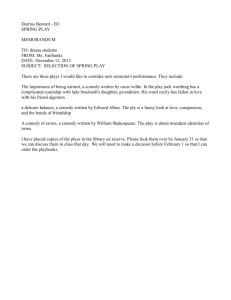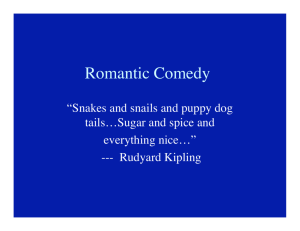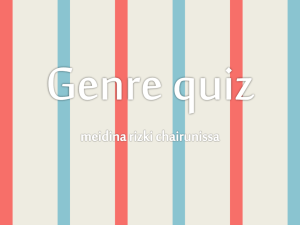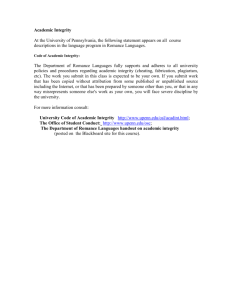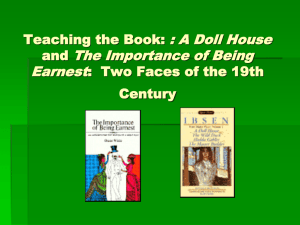Week 4 - University of Warwick
advertisement
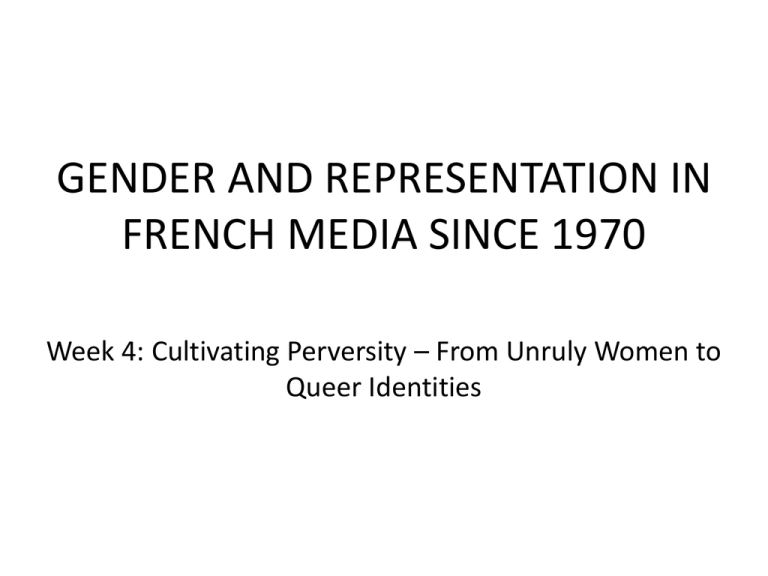
GENDER AND REPRESENTATION IN FRENCH MEDIA SINCE 1970 Week 4: Cultivating Perversity – From Unruly Women to Queer Identities Structure of the session • Assessment FAQs and information • The importance of studying popular cinema - Romantic comedy and its theorisations - The social relevance of rom-com and comedy • Romantic comedy in French cinema - Historical absence Adjacent genres; theatrical heritage Post-1990s shift: factors behind and features of new genre • Josiane Balasko and Gazon maudit in context • Feminist and queer scholarship and Gazon maudit - Discussion of Cixous and Rowe Homosexuality in France (MH); discussion of Ince Sequence analysis and discussion of film as a whole Screwball comedy – early 1930s to 1940s (and beyond?) A ‘genre of madcap romance’ (Wes D. Gehring); a ‘sex comedy without sex’ (Andrew Sarris). Characterised by fast-paced repartee and strong female characters. The ‘nervous romance’ (Frank Krutnik) - 1970s. Stronger female characters demanding sexual fulfilment in the post-liberationist era; realism over romance. The influential status of the discourse of romance in contemporary society • Diana Holmes, 2006. Romance and Readership in Twentieth-Century France: Love Stories. Oxford: Oxford University Press. • Celestino Deleyto, 2003. ‘Between Friends: Love and Friendship in Contemporary Hollywood Romantic Comedy.’ Screen 44, no. 2: 167–82. • Michel Foucault e.g. Histoire de la sexualité Vols. I and II (various editions). • Anthony Giddens, 1992. The Transformation of Intimacy: Sexuality, Love and Eroticism in Modern Societies. Cambridge: Polity Press. 1984 Romance’s social relevance and the question of realism – a red herring? See Guy Austin, 2008. Contemporary French Cinema. Manchester: Manchester University Press, p. 160 on: Le Fabuleux destin d’Amélie Poulain (2001). Classical French Cinema and the comédie boulevardière See Colin Crisp’s taxonomy of French popular genres of the classic era, taken from national press of the period, in Colin Crisp, The Classic French Cinema 1930-1960 (London: I.B.Tauris, 1997) • In 1988 Ginette Vincendeau has identified an ‘incestuous’ ‘father-daughter’ model of couple pairing in classical (1930s) French cinema, in Vincendeau, ‘Daddy's Girls (Oedipal Narratives in 1930s French Films).’ Iris no. 8: 70-81. • Noël Burch and Geneviève Sellier identify this paradigm in 300 out of one thousand films produced in that period and still frequent in decades since then. They point out that the term ‘incest’ allows us to relate screen thematics to ‘a psychosocial paradigm in real life, where the sexual abuse of young girls by men having power over them is not merely a daydream’. (Burch and Sellier 2002, p.153) Burch and Sellier also find this model to be frequent if not dominant in the portrayal of romances in subsequent decades. What about the New Wave? See Geneviève Sellier, La Nouvelle Vague: un cinéma au masculin singulier. Paris: Broché, 2005, Vincendeau (2000) in ‘New Wave, New Stars’ on ‘phantasmic male projections’ (p.113). Truffaut: ‘Filmmaking is pointing the camera at beautiful women.’ A bout de souffle (Godard, 1960) Vadim, 1956 Jules et Jim (Truffaut, 1962) Thérésa (Emma Valadon, 1837-1913): early star of the café-concert Cf. Josiane Balasko’s roots in the café théâtre French Women Filmmakers Since 1990: female directors have been responsible for between 14 and 19% of overall production during the period, compared with 9% in Hollywood in 1998, falling to only 5% in 2010. More specifically, for France, Carrie Tarr with Brigitte Rollet cite 14% for the 1990s (Tarr with Rollet. 2001. Cinema and the Second Sex: Women’s Filmmaking in France in the1980s and 1990s. London and New York: Continuum, p.1); and Ginette Vincendeau (2010) finds this to rise to 19.4% in the year 2009 (Vincendeau 2010. ‘The Rise and Rise of French Women Filmmakers: Victory for Feminism or French Exception?’ Paper delivered at ‘Women’s Filmmaking in France 2000-201’ conference, Institute of Germanic and Romance Studies, London, 4 December.) All basing data on CNC statistics – see http://www.cnc.fr/web/fr;jsessionid=16DB5765B3ABCB94C9C6F54059F50602.liferay For Hollywood, see Melissa Silverstein, 2014. ‘The Celluloid Ceiling: Behind-the-Scenes Employment of Women on the Top 250 Films of 2011.’ http://blogs.indiewire.com/womenandhollywood/what-bigelow-effect-number-ofwomen-directors-in-hollywood-falls-to-5-percent#.T_r9RpH_yVo. Coline Serreau, 1989 Other women auteurs in rom-com Reines d’un jour (Marion Vernoux, 2001) Chantal Akerman, 1996 Tonie Marshall, 1999 Catherine Corsini, 1999 … and more mainstream directors Palais Royal, Valérie Lemercier, 2005 Danièle Thompson, 2002 On the new trend for rom-coms by women see also: • Rollet, B. 2008. ‘Transatlantic Exchanges and Influences: Décalage horaire (Jet Lag), Gender and the Romantic Comedy à la française.’ In S. Abbott and D. Jermyn (eds), Falling in Love Again: Romantic Comedy in Contemporary Cinema. London: I.B. Tauris, pp. 92-104. • Harrod, M. 2012. ‘The réalisatrice and the rom-com in the 2000s.’ Studies in French Cinema 12, no.3: 227-240 • --------------2015 From France with Love: Gender and Identity in French Romantic Comedy (London: I. B. Tauris), especially the Introduction. Julie Delpy 2007 2012 Josiane Balasko: Popular Auteur 1998 1991 2008 The Frenchness of Gazon maudit Aesthetic…. …… and narrative ‘If on the high dramatic plane it is the son who kills and robs, it is the wife who plays this role on the plane of comic Gallic tradition’ (1984: 243 [1941]) Bakhtin, Rabelais and His World The cuckold Seminar Activity • Analyse the opening sequence of Gazon maudit (01.25-08.12). - How does this narrative fit with Kathleen Rowe's model of the subversion of conventional representations of gendered identities? - How is homosexuality depicted? Does this evolve (later in the film)? - At whom does the film laugh?
